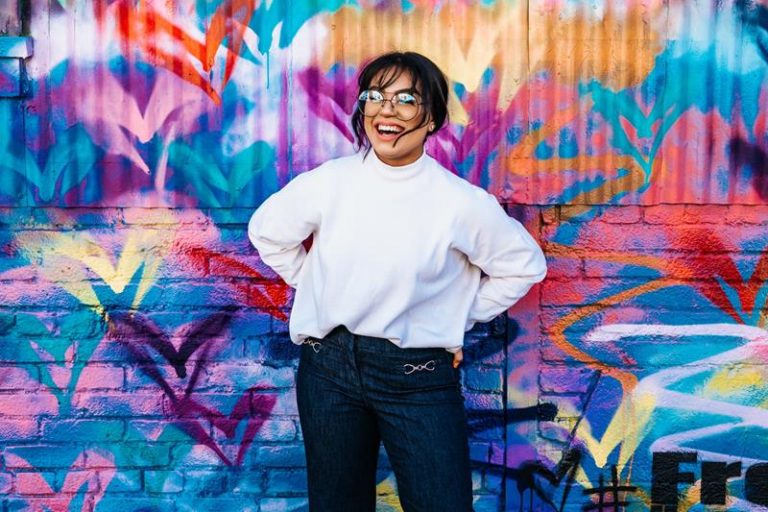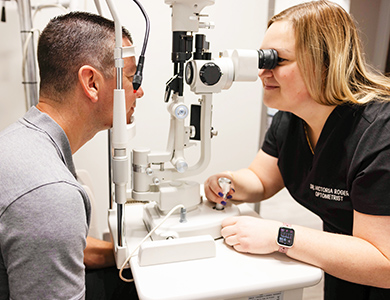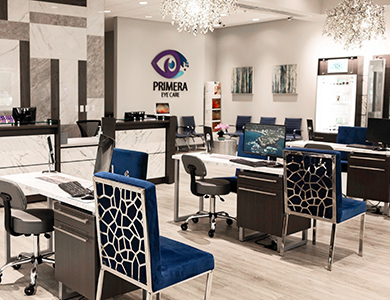
More people than ever before are using computers, smartphones, and other smart devices with screens for everything: from work, school, to entertainment. This means that eye strain and sleep disruption have become increasingly common problems.
Research shows that the average person in the United States spends approximately 10 hours and 39 minutes each day staring at a screen.
Staring at a computer screen for too long can cause tired eyes, dry eyes, headaches, difficulty concentrating, and other symptoms of eye strain. On top of that, devices emit blue light, which is also emitted by the sun to keep us awake during the day. This blue light inhibits the production of melatonin, which is what helps us sleep at night. Looking at screens too late into the night can prevent us from getting a good nights’ sleep.
Fortunately, there are blue-light-blocking glasses that can help. Experts disagree on whether or not they reduce eye strain, but some wearers have found that they help significantly. Blue-light blocking lenses are best at promoting sound sleep by blocking the blue light that could prevent melatonin production and, as a result, harm a good night’s sleep. Eyezen glasses aren’t just any blue light lenses, however. They have added technology built in to better address eye strain.
What Are Eyezen Blue Lenses?
Eyezen lenses are glasses that have been specifically engineered for wear while staring at a screen. They are single-vision glasses that come with not only blue light filtering (like other blue-light-blocking) lenses but also special WAVE technology and accommodative relief intended to prevent eye strain and sleep disruption.
What Is WAVE Technology?
The WAVE technology in Eyezen glasses helps to sharpen your vision when you’re looking at a computer screen. This may help to prevent eye strain by making sure that smudges and blurriness aren’t making your eyes work even harder than they need to.
What Is Accommodative Relief?
In Eyezen glasses, the accommodative relief helps to ease eye strain by including a slight magnification in the lenses. One source of eye strain when using a device is that they’re too close to our faces. Screens should actually be 15 to 25 inches away so we’re not focused so closely, but many people hold their smartphones at 12 inches away or even closer.
Some people have devices closer than is recommended because they can’t see the screens as well from father away. This is where Eyezen’s accommodative relief comes in. The small amount of magnification that they offer allows wearers to see better with devices held at a further distance, allowing them to reduce the risk of eye strain.
What Is Eyezen’s Smart Blue Filter?
Some experts believe that too much blue light harms our eyes and increases the risk of age-related eye problems like macular degeneration. Blue light is a wavelength of light emitted from the sun and keeps us awake during the day. Continued exposure to blue light, like through the use of phones, keeps us awake at night in a similar way.
Eyezen uses a trademarked Smart Blue Filter to filter out as much at 20% of the blue light coming from either a digital screen or the sun.
Why Do We Love Eyezen Blue Lenses?
Most blue-light-filtering glasses only filter blue light. Experts have differing opinions on whether or not blue light is behind digital device-based eye strain. And while blue light lenses are proven to help with sleep problems, experts are not agreed on whether or not blue light lenses help with eye strain.
Eyezen blue lenses do filter out blue light, but they also have two other approaches to reducing eye strain. The accommodative relief of the lenses can help wearers read more clearly from farther away to help reduce eye strain. In addition, the WAVE technology can help to reduce eye strain by reducing smudges and blurriness that could cause eye strain.
Eyezen blue lenses don’t just try to solve the problem of eye strain with one method. Instead, they offer three.
Need an Eye Exam?
Contact us to schedule an appointment.





